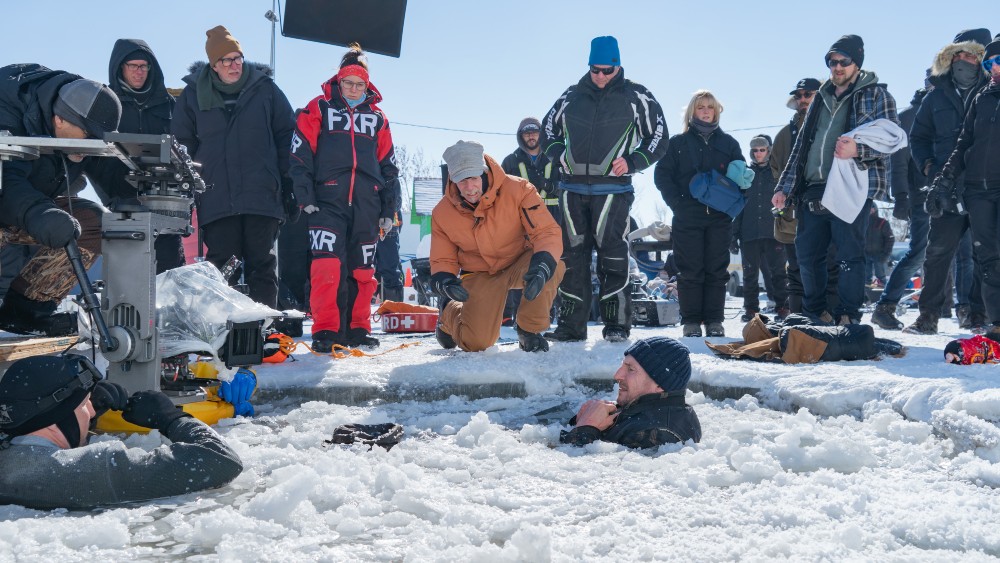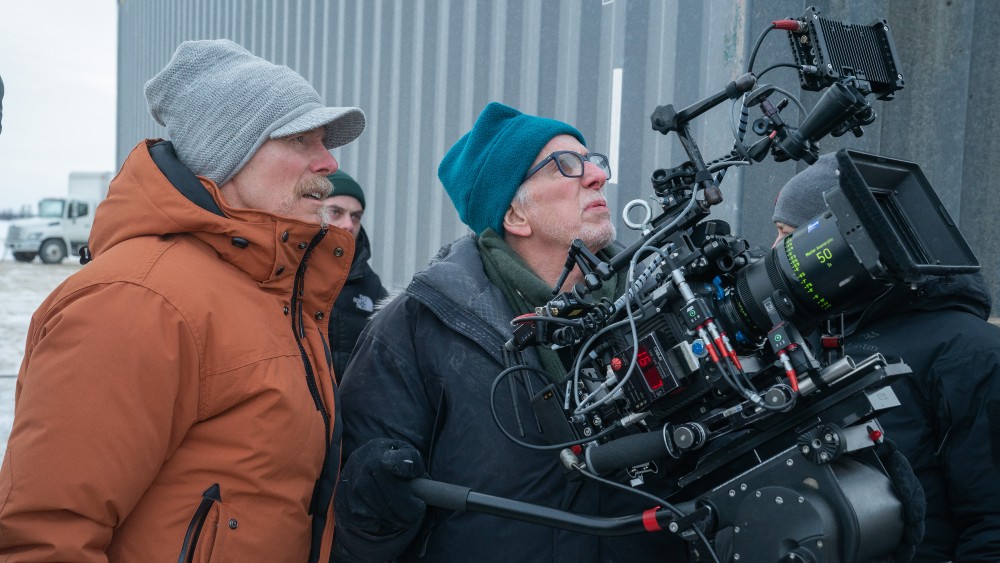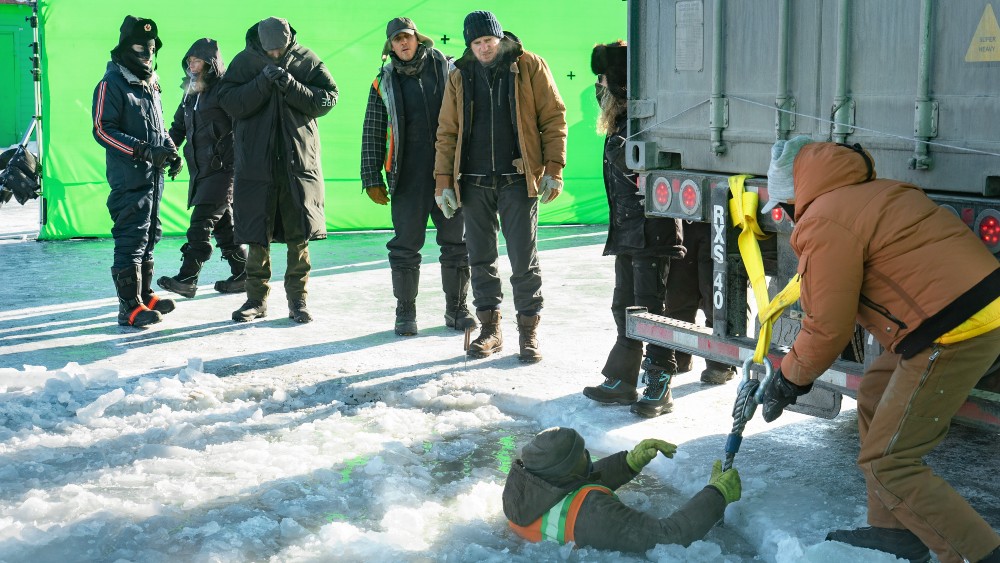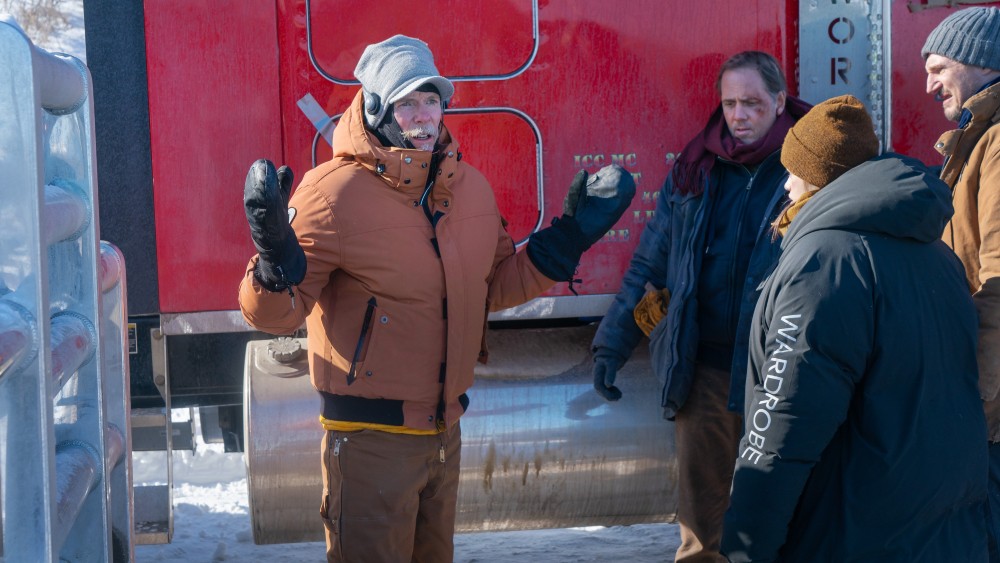
In the ‘90s, Jonathan Hensleigh was one of Hollywood’s go-to action screenwriters with the likes of Armageddon, Die Hard with a Vengeance, and Jumanji on his resumé. In 2004, he took on directing with the Lionsgate film, The Punisher, which was followed in 2011 with the indie crime thriller, Kill the Irishman.
Hensleigh’s latest film, The Ice Road, which debuts on Netflix this Friday, is the kind of big-screen action movie that began Hensleigh’s career. It stars Liam Neeson as a Winnipeg truck driver sent on a dangerous rescue mission to rescue workers in a collapsed mine in Northern Canada. To get there, he must lead a team of big-rig ice road drivers across the frozen Lake Winnipeg to get there. These truck drivers are used to making this run, but that doesn’t make it any less dangerous, and along with Laurence Fishburne’s Goldenrod and Amber Midthunder’s Tantoo, they go off on this hazardous mission, knowing full well that they might not all return.
More than anything else, The Ice Road, is an action movie unlike any you’ve seen before with real 18-wheelers driving across the actual frozen lake in sequences that would not look out of place in one of the Fast and Furious movies.
Below the Line got on Zoom with Mr. Hensleigh for the following interview about his exciting return to directing and how he managed to create some of his film’s unbelievable stunts.
Below the Line: Do you generally prefer to write the movies you direct? Is that kind of why it takes some time between your movies, because you’re writing something you want to direct?
Jonathan Hensleigh: [laughs] That’s a great question, actually. I guess I do sing for my supper that way. I think it’s the easiest way for me to get a film project going is for me to come with a document, a script or an outline, or even a concept that financiers want to make. And it just works out that way. I mean, to tell you the truth, if someone could write me a great script that I wanted to direct, I’d love that, and to not have to do that extremely difficult task myself. There aren’t great scripts flying around Hollywood that have no director attached. It’s very rare.
BTL: That’s true, so was The Ice Road done completely independently, separate from Netflix? It’s such a big movie, one that could be made by a studio for theatrical release.
Hensleigh: It was made entirely independently. It was financed by Code [Entertainment], and I developed it mostly with Al Corley, but Bart Rosenblatt as well, the two producers, and then it was sold to Netflix.
BTL: What kind of got you down this road? If you’re writing something, then it must be about a subject you’re interested in, in this case, these truckers and this dangerous journey they have to take driving across the ice.
Hensleigh: It was a marriage of two things. It was a marriage of what I perceived as really valuable, branded IP from the reality show, Ice Road Truckers, that had shown the world, this really exotic world. The idea was floated to use that as a fictional world for a feature film. I said to Code Entertainment, “Guys, I have always revered Wages of Fear, the Clouseau film. I saw it when I was a little kid, and it stuck with me forever. I said, “If I can do a film that’s inspired by Wages of Fear, where instead of this mountainous foreboding Andes region — they’re transporting TNT over in trucks — if I could use this equally perilous environment of brittle ice, especially brittle ice outside the safety window, in either November before the freeze or in April after the thaw, where the conditions that are already dangerous or even worse, if I could do that, I’ll write a script on spec, I’ll develop it, I’ll go the whole way, and they love the idea. They were extremely enthusiastic about it, and off we went.
BTL: I think I’ve seen the show, or I’ve heard about it. How do you proceed from there in terms of finding the location and finding the stunt drivers that can pull off some of those amazing sequences?
Hensleigh: Well, there’s a real ice road industry. In fact, the reality show touched on this, the real industry in Winnipeg, Manitoba, that has a bunch of trucking companies that use Lake Winnipeg and Lake Manitoba in the winter, to do heavy transports across those frozen surfaces up to communities and industries in Northern Manitoba. I said, “Look, this is perfect. We’ve got a tax rebate. Bart Rosenblatt, one of the producers at Code, was all over that, obviously. So Manitoba offered a wonderful tax rebate. Code had already made a film in Manitoba in Winnipeg, so they knew it well, and it just lined up perfectly. We had looked for a half-second at Romania, but we ditched Romania when Winnipeg lined up, and also, all my film crew, who are [from Winnipeg], they said, “Hey, Jonathan, this is the first time we’ve ever shot Winnipeg as Winnipeg,”
BTL: But it’s also Winnipeg in winter, which I don’t think anyone would recommend. I spoke to another director who did a movie in Montreal in the winter, and it was not fun.
Hensleigh: We identified the weeks in February, as the best weeks to shoot, when the ice surface would be thick enough to support the weight of these 18-wheelers. We think we’ve done a practical shoot that has a place in film history in that 18-wheelers, particularly 18-wheelers smashing into each other, they’ve never been shot on a frozen lake like this. They used frozen-over parking lots and stuff like that, hard surfaces, concrete, but never on real lakes.
BTL: Were you actually able to get underwater cameras underneath the ice to shoot the trucks from below, as we see in a few shots?
Hensleigh: Those are some of our few processed shots, but everything else, the practical shooting I insisted on, and the producers went with it, and I’m very pleased we did it that way. Al Corley had a relationship with Packard which is a parent company of Kenworth, and Kenworth gave us full hero rigs and full Kenworth cabs, which we then mounted on Ford F550s. And so we had our actors end up in the cabs with Tom Stern, the cinematographer, and myself in the sleeper cab behind the actors filming past the actors’ faces out through the passing landscape through the side windows and the windshield, as a stunt driver drove the F550 directly below us. That’s how we pulled it off.
BTL: I was going to ask how you found the stunt drivers who specialize in driving trucks like that, but I’m not sure I’ve ever seen three 18-wheelers just barrelling across the ice like that and crashing into each other.
Hensleigh: We brought in the best in the world, and those extraordinary professionals who are driving those rigs during those action sequences, having to control the skidding on the ice and not kill themselves or the actors or anything, those guys are the best in the world. And they did an absolutely extraordinary job as did Mark Vanselow, who is Liam’s stunt double, who is just incredible.
BTL: I don’t normally ask about casting, because actors are above the line, and we’re Below the Line, but I do want to ask how you found Amber Midthunder, who is just amazing. I’m not sure if she’s done other things, but I also learned that she’s going to star in the next Predator movie. How did you find her?
Hensleigh: I did extensive casting sessions with Mary Vernieu, our casting director in Hollywood, and I saw I think about… gosh, I certainly looked at the tapes of almost every single either Native-American or First Nations Canadian actress going in that age range, and we narrowed it down and then Amber, she just out-auditioned other candidates. I’m so proud of Amber, because I know she was just cast in Predator and her career is really on the ascendancy. I’m very proud of her.
BTL: Was she based in that part of Canada or was she already in Hollywood?
Hensleigh: I think Amber is in New Mexico. That’s her home, but she’s in Hollywood a lot. She’s working all the time now.

BTL: I’m glad you mentioned working with Tom Stern, because I know that when you make a movie every ten years, it’s hard to maintain the same crew from film to film. How do you go about putting together a crew — do you try to get some of the same people from previous movies, or do you generally know you’ll have to start from scratch?
Hensleigh: Ed, my next picture will definitely not be 10 years from now. I’m gonna work a lot more. I’ve been building up a liquor company actually, it’s called Smoke Wagon Bourbon here in Las Vegas. I didn’t retire from filmmaking, but I did focus a lot of my energy more on my entrepreneurial pursuits. But the itch is there again, and I think I’m going to be a lot more prolific after this. But Tom, I heard about his availability. My good friend Jon Turteltaub had hired Tom to shoot The Meg, and Jon raved about Tom. Tom didn’t need that. Tom is a legend — 25 films with Clint Eastwood — he’s a legend. As soon as his name came up, I just said, “Hire him, hire him, hire him…” I said to the producers, “Do whatever you can possibly do to get him on this film.”
BTL: What was involved with shooting in the cold winter, because I know that some cameras could have problems and even freeze if it gets too cold. Were there any problems in that sense?
Hensleigh: The camera team, other than Tom, were mostly local Manitobans, and they’re so experienced shooting in the harshest conditions. But yes, there is a constant threat of your cameras freezing — we avoided it, thank goodness.
BTL: The other big setting is the mine where you cut back to every once in a while, so was this something you found in that same area, which you shot separately from the outdoor truck stuff?
Hensleigh: The exterior of the mine is actually the water treatment plant of Greater Winnipeg, and the inside of the mine was a build. Our Production Designer, Arv Greywal, who tragically died, passed away of a heart attack a few months after the film, and it was just devastating to all of us on the film. But Arv designed and built that in our sound studio.
BTL: Did you end up doing all of your post during Covid remotely?
Hensleigh: The entire post was done during Covid.
BTL: What was involved? Were you working in Las Vegas with people either in New York or L.A.?
Hensleigh: The VFX company is MARZ — Monsters Aliens Robotz Zombies — out of Toronto, so I was remote with them, but I was editing in Las Vegas and Los Angeles.
BTL: I was pretty disappointed that I haven’t and probably won’t have a chance to see this in a theater, because I feel it would play great, but will this play in other countries theatrically?
Hensleigh: Oh, yeah, it’s got a full theatrical release in a lot of Europe, a lot of Asia, and Canada, I believe. So you might have to go over to Germany or something to see it. I would love to do that myself. I know Liam plans to see the picture on a screen in Europe at some point. Yeah, it’s our new reality with new business models, and I think both the business model of streaming and the business model of theatrical release are going to be hand in hand for some time now.
The Ice Road will be streaming on Netflix starting Friday, June 25.
All pictures courtesy Netflix, Photographer: Allen Fraser.







